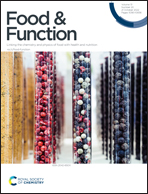The important role of glycerophospholipid metabolism in the protective effects of polyphenol-enriched Tartary buckwheat extract against alcoholic liver disease†
Abstract
Alcoholic liver disease (ALD) is a mounting public health problem with significant medical, economic and social burdens. Tartary buckwheat (F. tataricum (L.) Gaertn, bitter buckwheat) is a kind of healthy and nutritious food, which has been demonstrated to protect against ALD, but the underlying mechanism has not been fully studied. Herein, we aimed to elucidate the beneficial effects of Tartary buckwheat extract (mainly composed of polyphenols including rutin, quercetin, kaempferol and kaempferol-3-O-rutinoside) in terms of lipid metabolism with the aid of lipidomic analysis. In our study, we employed C57BL/6J mice and a Lieber–DeCarli alcohol liquid diet to construct an ALD model and found that Tartary buckwheat extract was able to prevent ALD-induced histopathological lesions, liver injury and abnormal plasma lipid levels. These beneficial effects might be attributed to the regulation of energy metabolism-related genes (SIRT1, LKB1 and AMPK), lipid synthesis-related genes (ACC, SREBP1c and HMGR) and lipid oxidation-related genes (PPARα, CPT1 and CPT2). In addition, lipidomic profiling and KEGG pathway analysis showed that glycerophospholipid metabolism contributed the most to elucidating the regulatory mechanism of Tartary buckwheat extract. In specific, chronic ethanol intake reduced the level of phosphatidylcholines (PC) and increased the level of phosphatidylethanolamines (PE) in the liver, resulting in a decrease in the PC/PE ratio, which could be all significantly restored by Tartary buckwheat extract intervention, indicating that the Tartary buckwheat extract might regulate PC/PE homeostasis to exert its lipid-lowering effect. Overall, we demonstrated that Tartary buckwheat extract could prevent ALD by modulating hepatic glycerophospholipid metabolism, providing the theoretical basis for its further exploitation as a medical plant or nutritional food.

- This article is part of the themed collection: Food & Function HOT Articles 2022


 Please wait while we load your content...
Please wait while we load your content...